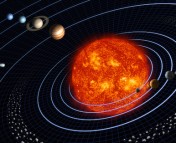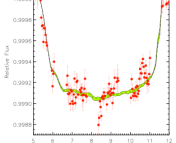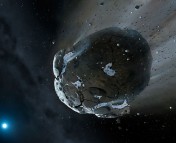Title: Friends not Foes: Strong Correlation between Inner Super-Earths and Outer Gas Giants
Authors: M. Bryan and E. Lee
Authors’ Institution: University of Toronto and McGill University
Status: ArXiv [open access]
We have found many exoplanet systems with close-in small planets (super-Earths and sub-Neptunes) and we have also found many exoplanet systems with distant gas giants like Jupiter. However, it is not clear how often these two kinds of planets form in the same planetary system. A system with a small, close in planet and a distant giant planet would begin to resemble our own Solar System, in that we have multiple rocky planets interior to multiple gas giant planets. We have found a few of these systems,and when astronomers find a few of something, they naturally want to compute an occurrence rate (see this bite).
Today’s paper looks at the occurrence rates of small and large planets in the same system. Occurrence rates attempt to quantify how often a particular outcome is expected to be observed. In exoplanet science, this represents how often a particular kind of planet will be found if one randomly surveys stars to search for planets. In particular, today’s paper looks to settle a debate. In the past, multiple different teams have attempted to measure the occurrence rate of systems with a distant gas giant planet, given that the system has an inner small planet. We call this the conditional occurrence rate, because we want to know how often Planet Type A will be found in a chosen system if we already know (aka “on the condition”) that Planet Tybe B occurs in that chosen system. Three of these past studies found a positive correlation between the conditional occurrence of these kinds of systems, that is to say, if you find an inner small planet, you are more likely to find a distant giant than you would be if you randomly looked at a system with no inner small planet. However, another study found no correlation, see this astrobite. No studies found an anti-correlation, that is, if you find an inner small planet, you are less likely to also find a distant gas giant than if you observed a random star with no inner small planet. It was recently found that the one dissenting study actually does find a positive correlation if you account for the metallicity of the host stars. Metallicity is the measurement of how much of the star is composed of elements heavier than hydrogen and helium. Higher metallicity means a higher percentage of the star is made up of heavy elements, aka “metals”.
Today’s paper builds on the finding that host star metallicity is an important metric for properly understanding the conditional occurrence rate of small close in planets and distant gas giant planets. The authors take all stars that have large publicly available radial velocity (RV) data sets and at least one confirmed small close-in planet. They also purposefully cut out any host stars that are M dwarfs, since it has been demonstrated that M dwarf stars have almost no distant gas giants (see this astrobite). Ultimately, they compile a sample of 184 systems, of which , 30 are known to have a distant gas giant planet. However, it is not as simple as saying 30/184 = 16% for the conditional occurrence. The authors have to take into account the completeness of the RV data sets to finding distant giants. Completeness quantifies y how sensitive the data is to finding a certain kind of planet, see this astrobite. For example, the RVs may have been sampled at times that are inopportune to finding a certain mass and period planet. To measure completeness for each of their 184 systems, the authors perform an injection/recovery test. They generate a planet with a given set of orbital parameters (period, eccentricity, inclination) and mass, then generate (inject) the expected RV curve for that simulated planet at the same timestamps as the real data’s observations, and then attempt to detect the simulated planet in the simulated data (recover). They do this thousands of times for different simulated planets and repeat this for each of the 184 data sets. From this test, they can quantify how many distant giant planets these data sets might have missed and how many they almost definitely did not miss. Using these completeness maps, they generate an average completion map, see Figure 1, from which they use to compute the conditional occurrence rate.
Figure 1: The color bar shows the average completeness map for this sample (bright colors are more complete, dark colors are less complete) with the detected distant gas giant planets overlaid as blue dots. Figure A.1 in the paper.
When they split the 184 systems into metal rich and metal poor systems, they get different values for the conditional occurrence rate. For metal rich stars (defined as more metallic than the Sun), they find a conditional occurrence of 28 +/- 5% and for metal poor stars, they find a rate of only 4.5 +/- 2.5%. This is a big and statistically significant difference! This difference rigorously re-affirms the previous hypothesis that the conditional occurrence rate depends on the host star metallicity. But this is not quite enough – we need to compare the conditional occurrence rate to the rate that just distant gas giant planets occur at, regardless of having an inner planet or not. If the rates are different, that tells us there is a relationship between the inner and outer system planets. Indeed the authors do find different rates! For metal rich stars, they find that regardless of the inner system, distant giant planets occur for 13% of stars and for metal poor stars they occur for 6% of stars. Therefore, because the conditional occurrence is enhanced (28% vs. 13%, see Figure 2), this points to a positive correlation: if you find an inner small planet you are more likely to find a distant gas giant than if you randomly searched for only distant gas giants!
This correlation has big implications for our understanding of exoplanet systems. It suggests that systems like our own Solar System, with small planets interior to large planets, might be more common than not. This study is also the first to have used so many systems to look for correlation with metallicity. Previous studies have used very small samples, simply because getting the data to do this kind of work is difficult and time consuming. By bringing together many more systems and building on previous work, this paper is able to make a more rigorous claim that there exists positive correlation between small inner planets and outer giants.
Figure 2: The probability distribution of the conditional occurrence rates for systems with inner small planets (red) versus without considering any inner planets (black). The red curve peaks at a higher rate than the black, so having an inner small planet enhances the occurrence of having a distant gas giant. Figure 2 in the paper.
Astrobite edited by Samantha Wong
Featured image credit: Bryan & Lee 2024




